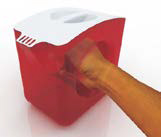Design of an optimal jar.
##plugins.themes.bootstrap3.article.main##
Abstract
One of the problems included in the course of Physics for the Industrial Design career of the Higher Institute of Design (ISDi) is how to design a jar that is optimal in terms of its use. It is a good example of application of concepts such as center of gravity, moment of a force, pairs of force and forces of ligature. In addition, it contributes to the professional approach of the subject and is interesting both from a methodological and conceptual point of view. Inspired by this problem, the project of a jar that responds to the requirements of being optimal and that could overcome the difficulties of other designs was developed.
##plugins.themes.bootstrap3.article.details##

This work is licensed under a Creative Commons Attribution-NonCommercial-ShareAlike 4.0 International License.
- Attribution — You must give appropriate credit , provide a link to the license, and indicate if changes were made . You may do so in any reasonable manner, but not in any way that suggests the licensor endorses you or your use.
- NonCommercial — You may not use the material for commercial purposes .
- No additional restrictions — You may not apply legal terms or technological measures that legally restrict others from doing anything the license permits.
- ShareAlike — If you remix, transform, or build upon the material, you must distribute your contribution under the same license as the original. NOTE: This point applies to numbers 1 to 20 of the magazine with the previous CC-BY-NC-SA 4.0 license. Does not apply to the new CC BY-NC 4.0 license from Volume 11, Number. 21 (2024).
References
Berazaín A. (2000). Enfoque profesional de la asignatura Física de los Productos para la carrera de Diseño Industrial. La Habana. Universidad de Ciencias Pedagógicas Enrique José Varona.
Beer F. P y Russell E. (1988). Mecánica vectorial para in- genieros. Tomo I. La Habana. Edición Revolucionaria.
Cutnell J. y Johnson K. (1995). Physics. New York. John Wiley and sons.
Facón H. M. y Montenegro E. I. (2014). Los problemas abiertos: una vía para facilitar las tareas integradoras en la enseñanza. En Atlante. Cuadernos de Educación y Desarrollo.
Giancoli D. (1991). Physics, principles with applications.
N. Jersey. Prentice Hill.
Gil D. et al. (1996). La resolución de problemas en Física: de los ejercicios de aplicación al tratamiento de las situaciones pro- blemáticas. En: Temas Escogidos de la Didáctica de la Física. La Habana. Editorial Pueblo y Educación.
Fishbane T. (1993). Physics for scientist and engineers. N. Jersey. Prentice Hill.
Halliday D., Resnick R., Walker J. (2014). Fundamentals of Physics. 10th ed. New York. John Wiley & Sons.
Lucero I. et al. (2006). El análisis cualitativo en la resolución de problemas de Física y su influencia en el aprendizaje significativo, Investigações em Ensino de Ciências, V11 (1), pp. 85-96.
Meriam J. L. (1967). Mecánica. La Habana. Edición Re- volucionaria.
Natali, O. (2012). Uso de situaciones problemáticas abier- tas en las clases prácticas de Física: una innovación. Actas III Jornadas de Enseñanza e Investigación Educativa en el campo de las Ciencias Exactas y Naturales, FHCE. Universidad Nacional de La Plata.
Sifredo C. (1999). La resolución de problemas en el proceso de enseñanza aprendizaje de la Física. En: El proceso ense- ñanza-aprendizaje de la Física en las condiciones contemporá- neas. La Habana. Editorial Academia.
Smith W. (1999). Fundamentos de la Ciencia e Ingeniería de materiales. Madrid. Mac Graw Hill.
Tippens P. (1993). Física, conceptos y aplicaciones. México. Mac Graw Hill.
Wilson J. (1995). Física con aplicaciones. México. Edito- rial Interamericana.
Zebrowski E. (1984). Física: un enfoque para técnicos. Edi- torial Calipso.






















